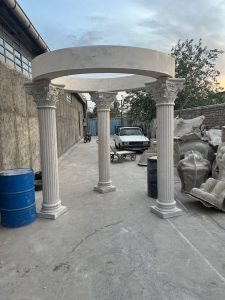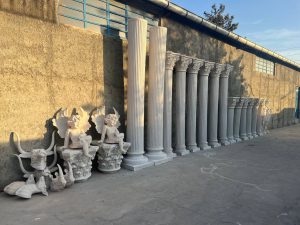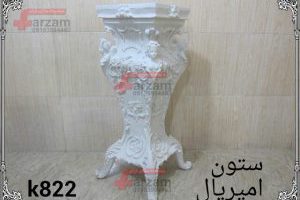Roman columns : A glimpse of ancient architecture
Roman columns are one of the most iconic and recognizable features of ancient architecture. They have stood the test and continue to inspire modern architects around the world. But what exactly makes these columns so special?
In this blog, we take a deep dive into the importance of Roman columns, exploring their rich history, design elements, and cultural significance.. We will also discuss the different types of Roman columns such as Doric, Ionic, Corinthian, and Triumphal. From Trajan's Column to the Roman Forum and the Pantheon, we'll explore how these columns have been used in some of the most iconic architectural landmarks throughout history..
Finally, we will look at why many famous buildings still use Roman column designs and how they are still relevant in contemporary architecture.. Join us on this journey through time to explore the beauty and majesty of Roman columns.
Understanding the importance of Roman columns
Roman columns, the basic element of ancient Roman architecture, were very important in the construction of symbolic structures. Beyond their structural purpose, these columns also functioned as complex and decorative elements and displayed the exceptional art of the Roman Empire..
In addition, they were a symbol of strength, power and majesty and evoked a sense of awe and admiration. One of the notable examples is the Phokas Column, which is a triumphal column commemorating the victory of an emperor. Even in modern times, the influence of Roman columns can be seen in the architectural designs of buildings around the world..
From the different types of columns, such as the Doric, Ionic, and Corinthian orders, to the use of materials such as granite, limestone, and even geographical references to Spain, Russia, and Romania, the aesthetic influence of Roman styles is undeniable.. These columns bear witness to the enduring legacy of ancient Rome and connect us to the rich history and glory of antiquity.
Three key types of Roman columns
Roman styles of columns can be classified into three distinct types: Doric, Ionian and Corinthian. Doric columns are influenced by ancient Greece and are characterized by their simple and solid design.
They do not have a base and have a capital with a simple circular molding. On the other hand, Ionic columns, which are also inspired by Greek architecture, are more complex. They have decorative bases, narrow shafts, and screws in their capitals. Finally, Corinthian columns represent the pinnacle of Roman art. They display intricate acanthus leaves on their capitals that exude elegance and beauty..
These types of columns reflect the evolution of architectural styles, each of which has its own distinct characteristics. Architects have used these columns to create diverse and visually attractive structures.
Doric columns: Simplicity of early Greek influence
Doric columns, which represent the simplicity of ancient architecture, were the oldest type of Greek column. These columns have a simple and solid design and do not have excessive decorations. They were commonly used in ancient temples, churches and other public buildings. One notable example is Trajan's Column, a triumphal column depicting the victory of the emperor.
The architectural features of Doric columns, including column tops, bases, and shafts, provided the necessary support for buildings.. The influence of Doric columns can be seen in various Roman styles, indicating the influence of ancient Greece on Roman architecture..
These columns played a significant role in conveying the greatness and power of the Roman Empire. From Spain to Romania, the durability and timeless beauty of Doric columns is still evident in structures made of granite, limestone, and other materials.. Their simplicity and association with antiquity make them a lasting symbol of gods and victories.
Ionic columns: Greek sophistication meets Roman aesthetics
Greek sophistication meets Roman aesthetics in the form of Ionic columns. Influenced by the style of ancient Greek architecture, these columns display a design characterized by decorative screws, bases, and slender shafts.. The complexity of this type of columns can be seen in its stylish appearance and complex construction.
Ancient Roman buildings, such as the Theater of Marcellus, often had Ionic columns that added elegance to their architecture.. Another notable example is the Column of Marcus Aurelius, which commemorates the emperor's victory in the Dacian Wars. These triumphal columns highlight the importance of Ionic columns in conveying the grandeur and glory of Roman victory.
One of the distinguishing features of Ionic columns is the use of acanthus leaves as decoration. These exquisite details add a unique aesthetic appeal to the buildings they decorate, further showcasing the artistic skill and creativity of the Roman Empire.. With their slender proportions and decorative elements, Ionic columns embody a harmonious combination of Greek sophistication and Roman aesthetics in ancient architecture..
Corinthian columns: The height of Roman art ( Roman columns )
Corinthian columns, the epitome of Roman art, display intricate artistry through their elaborate acanthus leaf capitals.. These columns were widely used in Roman architecture, and notable examples are found in iconic structures such as the Pantheon.. One of these prominent Corinthian columns is the Column of Marcus Aurelius. It stands as a triumphal column and commemorates the emperor's victory in the Dacian wars. The presence of Corinthian columns in this historical building emphasizes their importance in Roman culture.
The luxurious decorations of acanthus leaves on the Corinthian columns add grandeur and beauty to these architectural elements. Their inclusion in ancient Roman buildings reflects the empire's penchant for sophistication and elegance. Today, the Corinthian order continues to influence architectural design around the world and serves as a testament to the enduring legacy of Roman styles..
Columns of victory: Celebration of Roman victories ( Roman columns )
Victory columns, such as Trajan's Column, were built in ancient Rome to celebrate the victories of Roman emperors and symbolize imperial conquests.. Decorated with intricate reliefs, these historic structures serve as historical records of Roman military achievements.. The Column of Marcus Aurelius, another triumphal column, depicts the emperor's victory in the Dacian Wars, marking the conquest of Dacia by the Roman Empire..
With their meticulous craftsmanship, these columns played an important role in commemorating Roman victories and preserving the history of the empire. Triumphal columns, such as Trajan's Column, displayed the triumph of the emperor and the power of the Roman army, inspiring awe and admiration.. By depicting battles, victories and scenes from ancient Roman life, these columns gave a glimpse of the greatness and glory of the Roman Empire..
Trajan's Column: Victory Memorial
Trajan's Column, which is a historical representation of the conquests of the Roman Empire during the time of Emperor Trajan, is a testimony to the power and dominance of ancient Rome.. Located in Rome, Italy, this triumphal column is decorated with detailed reliefs depicting Emperor Trajan's victories in the Dacian Wars.. This architectural masterpiece, made of marble, is an example of the art of ancient Rome.
Trajan's column, which is impressive in height 30 Standing Roman foot attracts visitors from all over the world with an inspiring image of the Roman conquest. The intricate relief and grandeur of the column make it an iconic architectural feature. It serves as a visual testimony of the empire's military victories, preserving the history and antiquity of the Roman Empire.
With its importance in Roman military history and its enduring appeal, Trajan's Column remains a captivating sight that allows visitors to explore the ancient world..
Roman columns in architectural landmarks
The architectural landmarks of ancient Rome, such as the Roman Forum and the Pantheon, are remarkable examples of the grandeur of the city. These places showcase the intricate beauty of Roman columns and give us a glimpse of the ancient civilization and its architectural achievements.. In the heart of Rome, the Roman Forum served as the center of political, religious and social life. The magnificent basilica, its buildings and columns showed the skill of the empire's architecture.
Meanwhile, the Pantheon, a Roman temple, captivates visitors with its Corinthian columns, stucco decorations and iconic dome.. The Pantheon stands as a testament to the genius of Roman architecture and is admired for its marble columns and stunning design..
Both these architectural signs speak of the antiquity of Rome and its worshiped gods. While the Roman Forum epitomizes Roman styles, the Pantheon showcases the elegance and beauty of Corinthian columns.. These landmarks, with their rich history and architectural wonders, continue to inspire awe and admiration in visitors from around the world..
Roman Forum and Pantheon: A study in contrasts
The Roman Forum, located in the ancient heart of Rome, Italy, displays the remains of various ancient Roman buildings, such as churches, temples, and columns.. This historic site served as the political, religious and social center of ancient Rome and witnessed the architectural achievements of the empire. In contrast, the Pantheon is one of the best-preserved Roman buildings, with its Corinthian columns, plasterwork, and iconic dome..
The unique architectural design of the Pantheon creates a striking contrast when compared to the ruins of the Roman Forum. These architectural landmarks with their Roman columns give visitors a glimpse of the ancient Roman civilization, its triumphs and different architectural styles..
While the Roman Forum serves as a reminder of the antiquity and power of imperial architecture, the Pantheon leaves visitors in awe of Roman craftsmanship and their ability to create stunning architectural masterpieces..
How are Roman columns relevant in today's architecture?
Roman columns continue to inspire modern architects and designers with their iconic styles. Their influence can be seen in buildings around the world, showcasing the lasting legacy of ancient Rome. From the Doric, Ionic, and Corinthian columns of the Colosseum to triumphal columns like Trajan's, these architectural features symbolize victory, triumph, craftsmanship, and historical significance..
Why do many famous buildings use the Roman column design?
Roman column designs are widely used in famous buildings due to their association with grandeur and strength. The Renaissance period witnessed the popularity of these columns in architecture. Their versatile design can be adapted to fit a variety of architectural styles and convey a sense of power and authority, as seen in buildings such as the White House and the US Capitol..
Frequently Asked Questions
What are the types of Roman columns and their distinctive features?
Roman columns can be classified into three types: Doric, Ionic and Corinthian. Each type has its own distinctive features. Doric columns are simple without bases and capitals. Ionic columns have bases and capitals decorated with beads. Corinthian columns have bases and capitals decorated with acanthus leaves and small scrolls..
How were Roman columns used in ancient architecture?
Roman columns played an important role in ancient architecture and had both structural and aesthetic purposes. They supported buildings while adding grandeur and elegance to public spaces. With styles such as Doric, Ionic, and Corinthian, Roman columns continue to be used as a tribute to classical design..
Are there any modern architectural styles that incorporate elements of Roman columns?
Modern architectural styles often incorporate elements of Roman columns. Neoclassical and Beaux Arts architecture often features columns based on Roman orders, while contemporary architects may use columns to decorate or support a structure.. The use of modern materials such as concrete allows creative interpretation of Roman column designs.
What is the importance of Doric, Ionic and Corinthian columns?
Doric, Ionic and Corinthian columns are very important in ancient architecture. Known for its simplicity, the Doric style was commonly used in temples and public buildings. The Ionic style featured decorative screws on the capitals, symbolizing Greek sophistication.
The Corinthian style was the most ornate style with acanthus leaves adorning the capital and showcasing Roman art.. Each style had its own unique characteristics and historical significance.
Result
In conclusion, Roman columns have left an indelible mark on the world of architecture. Their grandeur, elegance and durability continue to inspire modern architects and designers. The three main types of Roman columns – Doric, Ionian and Corinthian – They show the evolution of architectural styles and the influence of Greek aesthetics. Victory columns, such as Trajan's Column, serve as powerful symbols of Roman conquest and victory.
Roman columns can be seen in landmarks such as the Roman Forum and the Pantheon, where they add a sense of grandeur and timelessness.. Today, many famous buildings still use Roman column designs because they evoke a sense of history, sophistication and timeless beauty..



 Fiberglass columns Naghshineh k816
Fiberglass columns Naghshineh k816 Crock fiberglass columns k821
Crock fiberglass columns k821 Fiberglass columns
Fiberglass columns Imperial fiberglass columns k822
Imperial fiberglass columns k822